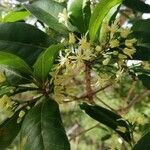A bushy shrub. It grows 5-10 m tall and spreads 3-6 m across. The leaves have one leaflet which is oval. Leaves are 2-9 cm long by 1-5 cm wide. They are bright green and shiny on both sides of the leaf. There are several small oil dots. The end of the leaf is blunt. The flowers and small and white or cream. The flowers are 1.2 cm across and occur on branched flower stalks 2-7 cm long. These are in the angles where leaves join the stem. The fruit is pink or purple. It is ribbed and about 1 cm across.


